Fisheries Production Improved in 2023
In 2023, the total fisheries production in Aklan was estimated at 19,868 metric tons, marking an 11.24 percent increase from the 17,860 metric tons recorded in 2022. This growth is mainly due to increased production across all fisheries sectors. Commercial fisheries experienced an increase of 213.48 percent, indicating that 2023 production was more than three times higher than in 2022. There are two sectors that comprise municipal fisheries: marine fisheries and inland fisheries. These sectors experienced a 3.2 percent increase and 24.81 percent decrease, respectively. Despite the decline in inland fisheries, municipal fisheries overall increased by 0.91 percent. However, aquaculture fisheries production decreased by 18.92 percent in 2023 compared to 2022.

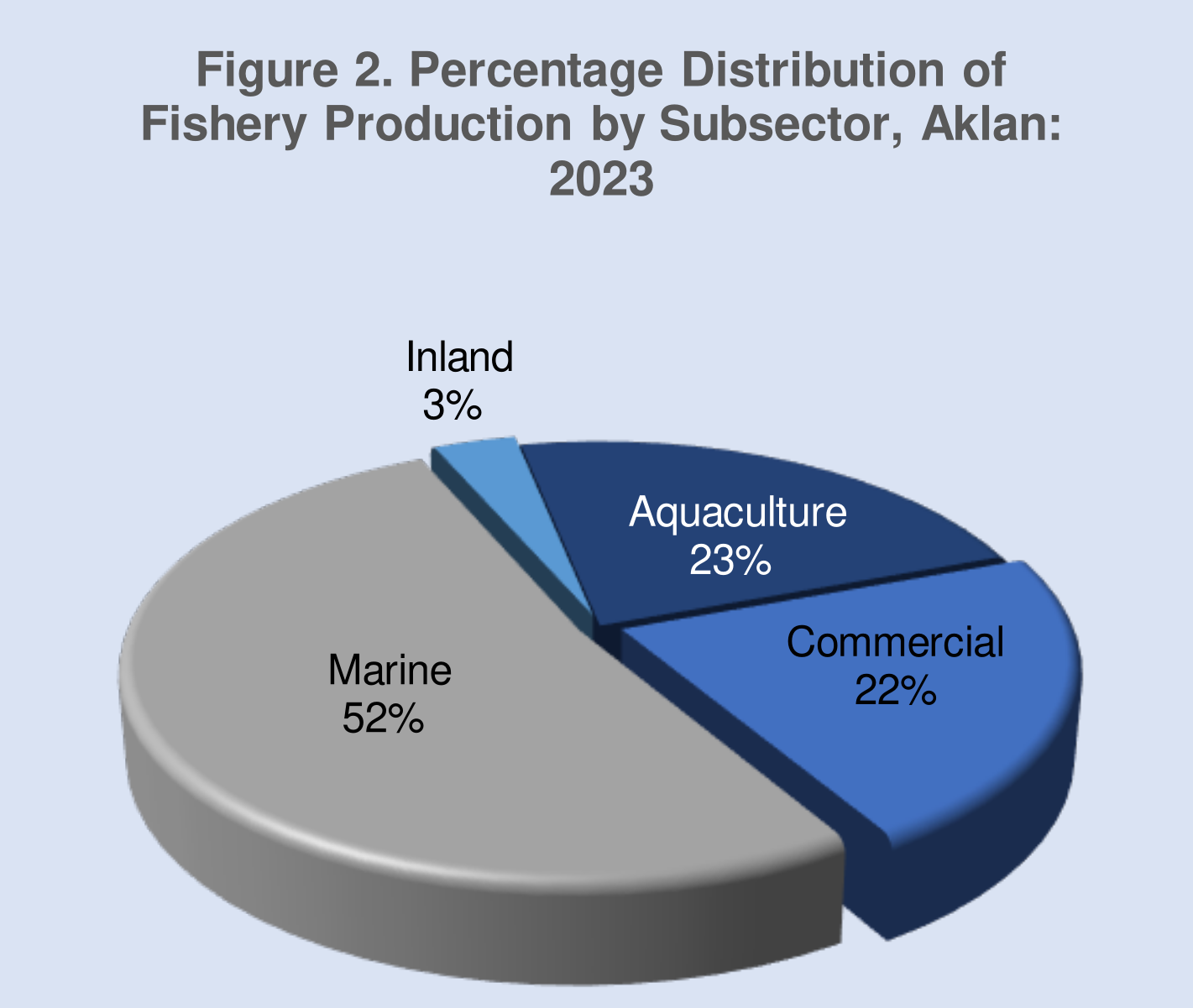
During this period, marine fisheries accounted for the largest share of total production, contributing 52.04 percent or 10,338.69 metric tons. This was followed by aquaculture fisheries, which made up 22.68 percent or 4,506.90 metric tons, and commercial fisheries, with a 21.88 percent share or 4,346.51 metric tons. Inland fisheries contributed 3.40 percent, equivalent to 675.82 metric tons.
The value of fishery products amounted to Php 2,424,993.30 in 2023, translating to Php 122.056 per kilogram. The total value of fisheries production increased by 8.93 percent, while the total value of fisheries production per kilogram decreased by 2.08 percent.
Galunggong emerged as the top species in the Commercial sector
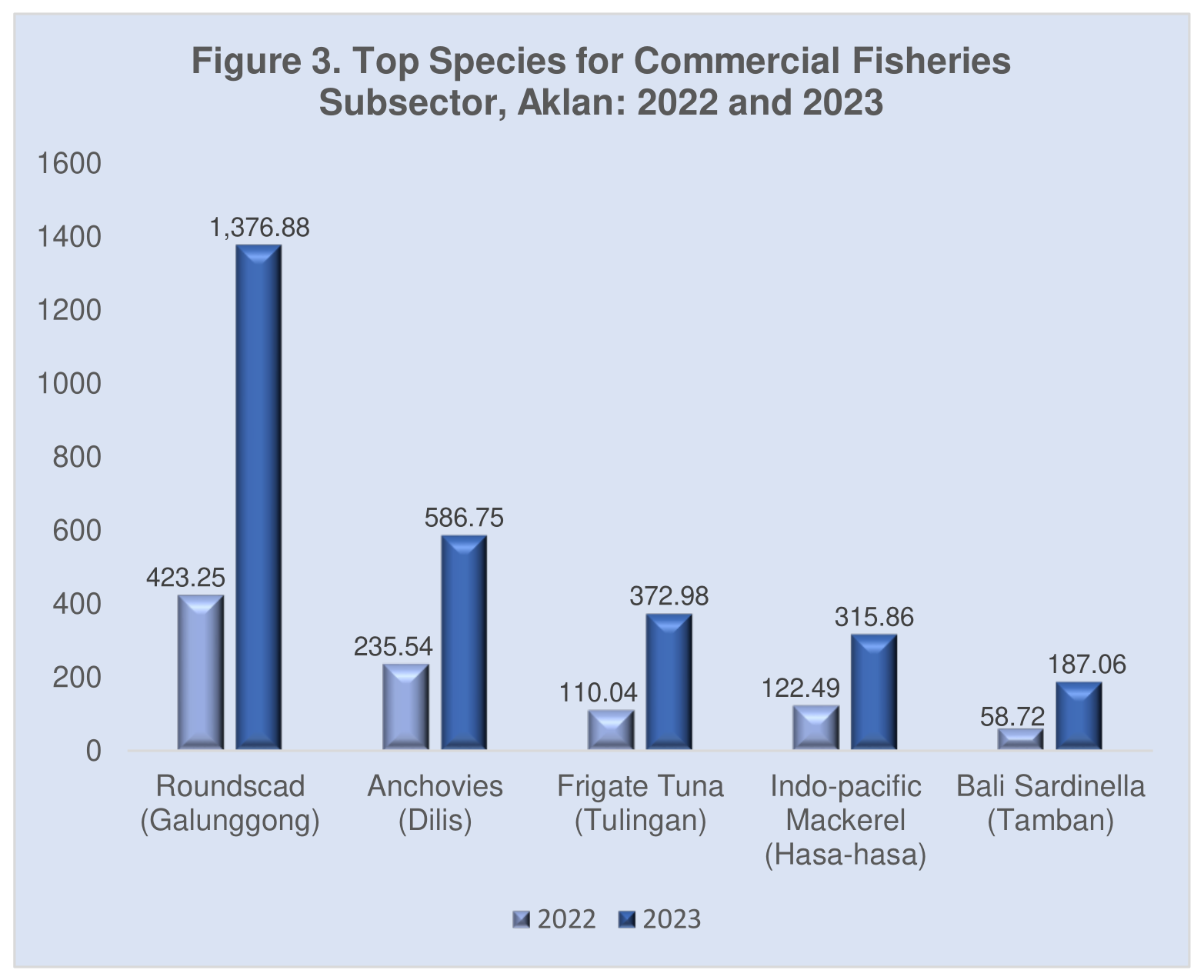
The estimated volume of commercial fishing production in Aklan for 2023 was 4,346.51 metric tons, marking a significant increase of 213.48 percent from the 1,386.54 metric tons produced in 2022. The value of fish in 2023 reached Php 536,500.54, or Php 123.43 per kilogram. This total value is 184.84 percent higher than the Php 188,351.88 recorded in 2022, though the per kilogram value decreased by 9.14 percent from Php 135.84 the previous year.
Among the species of fishes caught in this sector, Roundscad (Galunggong) had the highest catch at 1,376.88 metric tons, accounting for 31.69 percent of the total commercial fisheries output. This is higher than the 423.25 metric tons in 2022. Other prominently produced species are the following: Anchovies (Dilis) with 586.75 metric tons (13.50%), Frigate Tuna (Tulingan) with 372.98 metric tons (8.58%), Indo-pacific Mackarel (Hasa-hasa) with 315.86 metric tons (7.27%), and Bali Sardinella (Tamban) with 187.06 metric tons (4.30%).
Municipal Fisheries Production
In 2023, the total municipal fisheries production was 11,014.51 metric tons. There was an increase of 0.91 percent compared to 10,914.71 metric tons recorded in 2022. This growth was primarily due to an increase in the marine fisheries sector, which accounted for about 94 percent (previously 92 percent) of the overall municipal production.
Marine fisheries production increased by 3.22 percent
The marine fisheries sector experienced a growth of 3.2 percent in 2023. From 10,015.86 metric tons in 2022, it increased to 10,338.69 metric tons during the reference year. The value of fish in 2023 reached Php 1,423,823.15, or Php 137.72 per kilogram. The total value and value per kilogram decreased by 0.59 percent (from Php 1,432,212.87 in 2022) and 3.69 percent (from Php 142.99 in
2022), respectively.

In 2023, the estimated volume of production of inland fisheries is 675.82 metric tons, indicating a 24.81 percent decrease from 898.85 metric tons in 2022. The value of fish reached Php 94,481.85, or Php 139.80 per kilogram. The total value and value per kilogram increased by 12.63 percent (from Php 83,886.42 in 2022) and 49.80 percent (from Php 93.33 in 2022), respectively. Among the species of aquatic animals caught in this sector, fishes (species not specified) had the
highest catch at 123.66 metric tons, accounting for 18.30 percent of the total inland fisheries output. This is higher than the 122.44 metric tons in 2022. Other prominently produced species are the following: Freshwater Goby (Biya) with 80.65 metric tons (11.93%), Mullet (Kapak) with 65.79 metric tons (9.73%), Blue Crab (Alimasag) with 61.10 metric tons (9.04%), and Freshwater Crab (Talangka) with 60.31 metric tons (8.92%).
Aquaculture fisheries production experienced decline in 2023
The estimated volume of production of aquaculture fisheries is 4,506.90 metric tons in 2023. This marked an 18.92 percent decrease from 5,558.62 metric tons in 2022. The value of fish reached Php 370,187.76, or Php 82.14 per kilogram. The total value and value per kilogram decreased by 29.04 percent (from Php 521,683.39 in 2022) and 12.48 percent (from Php 93.85 in 2022), respectively.

The top two species of aquatic animals caught in this sector are: BF – Milkfish with 2,623.06 metric tons (58.20%) and Oyster with 1,772.45 metric tons (39.33%). Other prominently produced species are the following: BF – Tilapia with 29.65 metric tons (0.6%), BF – Mudcrab with 13.79 metric tons (0.3%), and BF – P.Vannamei with 9.94 metric tons (0.2%).

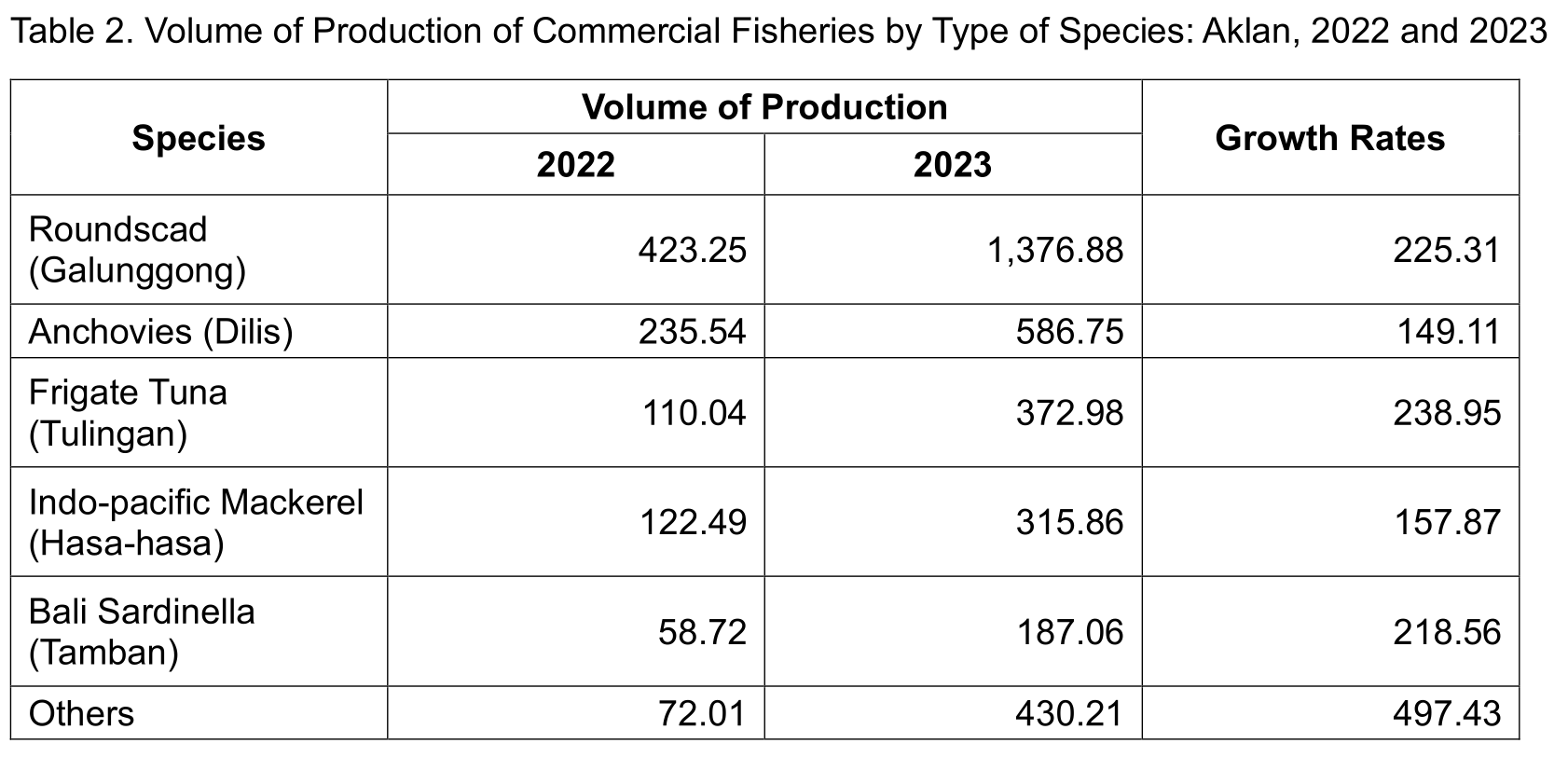
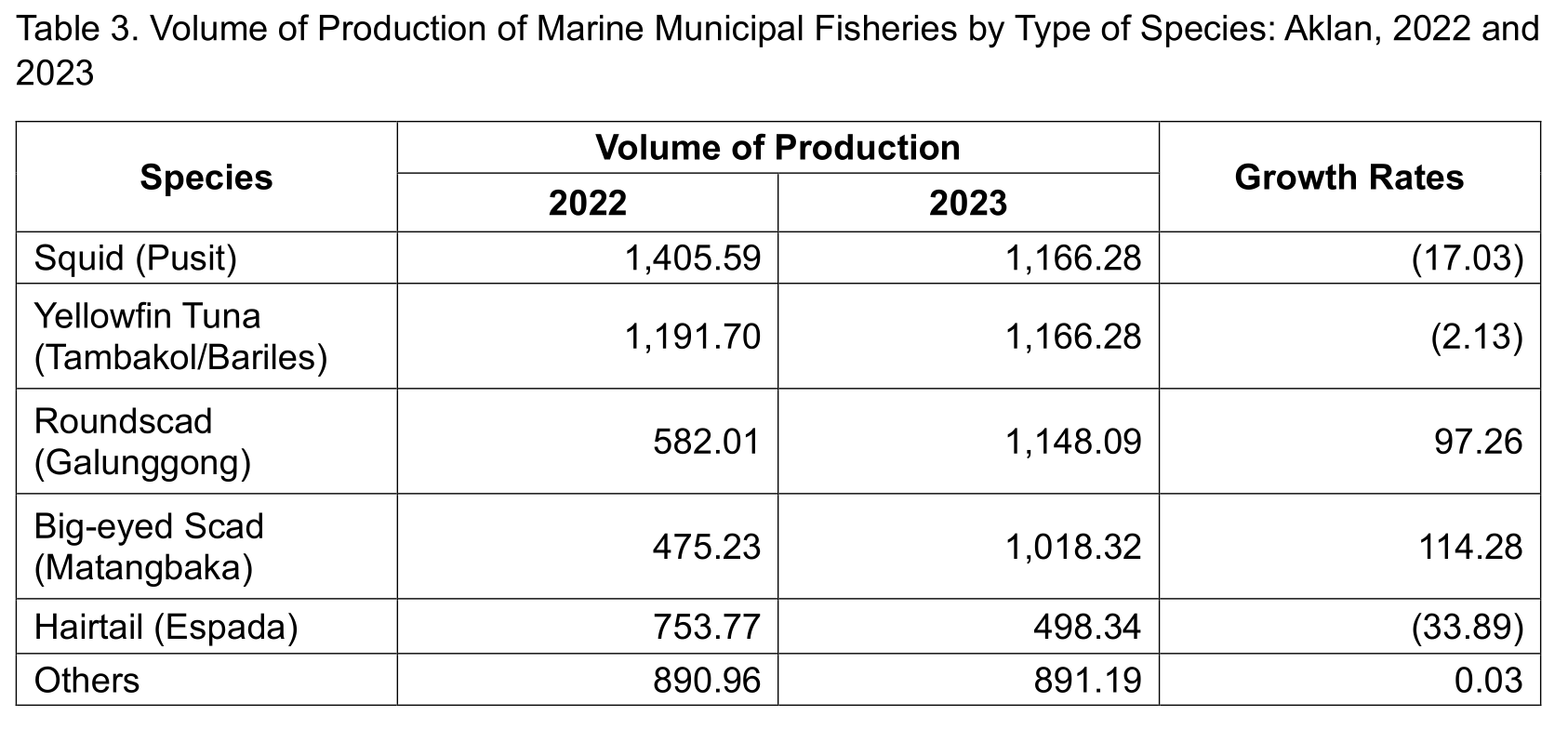
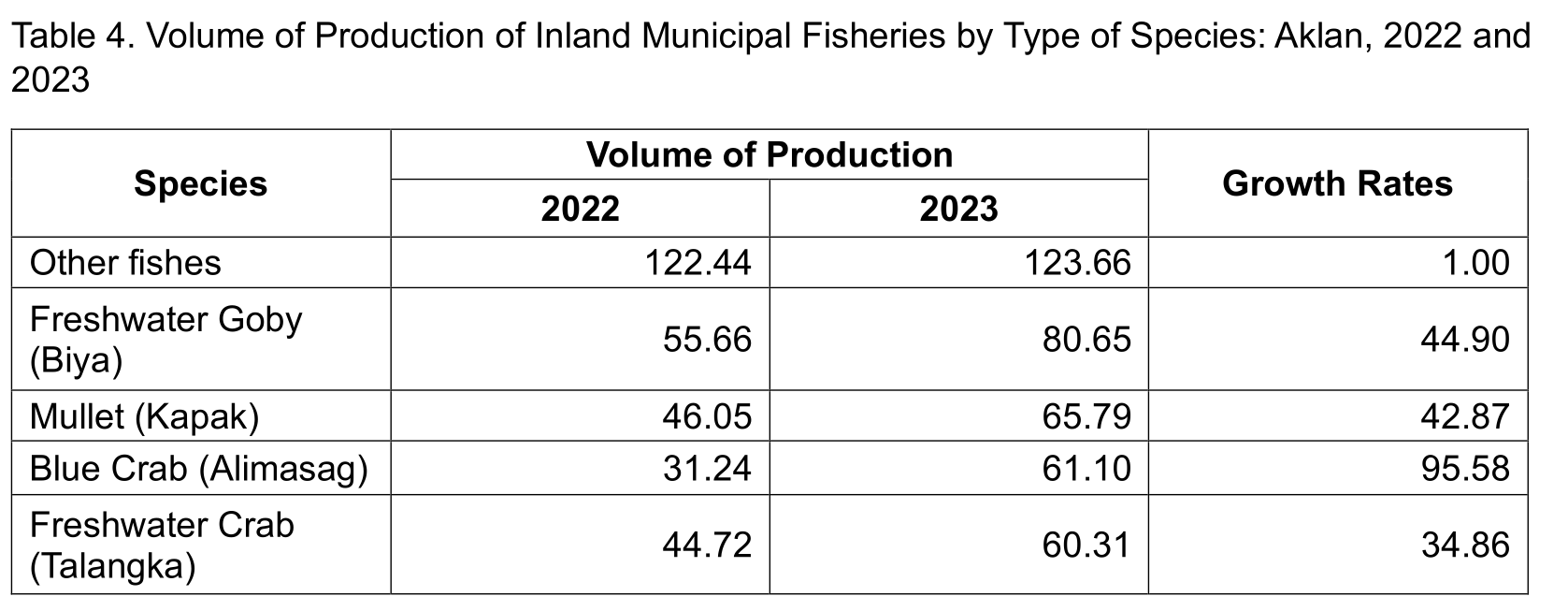

TECHNICAL NOTES
The Fisheries Situation Report was derived from the four (4) major surveys --- the Quarterly Commercial Fisheries Survey (QCFS), Quarterly Municipal Fisheries Survey (QMFS), Quarterly Inland Fisheries Survey (QIFS), and Quarterly Aquaculture Survey (QAqS). These surveys aim to provide quarterly data on volume and value of fish production by species and by environment.
Aquaculture – fishery operation involving all forms of raising and culturing of fish and other fishery species in marine, brackish and fresh water environment.
Aquafarm – the farming facilities used in the culture or propagation of aquatic species including fish, mollusc, crustaceans, and aquatic plants for purposes of rearing to enhance production.
Brackishwater – mixture of seawater and freshwater with salinity that varies with the tide.
Commercial Fishing – the catching of fish with the use of fishing boats with a capacity of more than three (3) gross tons for trade, business or profit beyond subsistence or sports fishing.
Fish Cage – stationary or floating fish enclosure made of synthetic net wire/bamboo screen or other materials set in the form of inverted mosquito net (“hapa” type) with or without cover with all sides either tied to poles staked to the water bottom or with anchored floats for aquaculture purposes.
Fish Pen – an artificial enclosure constructed within a body of water for culturing fish and fishery/aquatic resources made up of bamboo poles closely arranged in an enclosure with wooden materials, screen or nylon netting to prevent escape of fish.
Fishpond – a body of water (artificial or natural) where fish and other aquatic products are cultured, raised or cultivated under controlled conditions.
Inland Municipal Fishing – the catchng of fish, crustaceans, mollusks and all other aquatic animals and plants in inland water like lakes, rivers, dams, marshes, etc. using simple gears and fishing boats, some of which are nonmotorized with a capacity of three (3) gross tons or less; or fishing not requiring the use of fishing boats.
Landing Center – place where the fish catch and other aquatic products are unloaded and traded.
Municipal Fishing – covers fishing operation carried out with or without the use of a boat weighing three (3) gross tons or less.
Chief Statistical Specialist PSA Aklan

